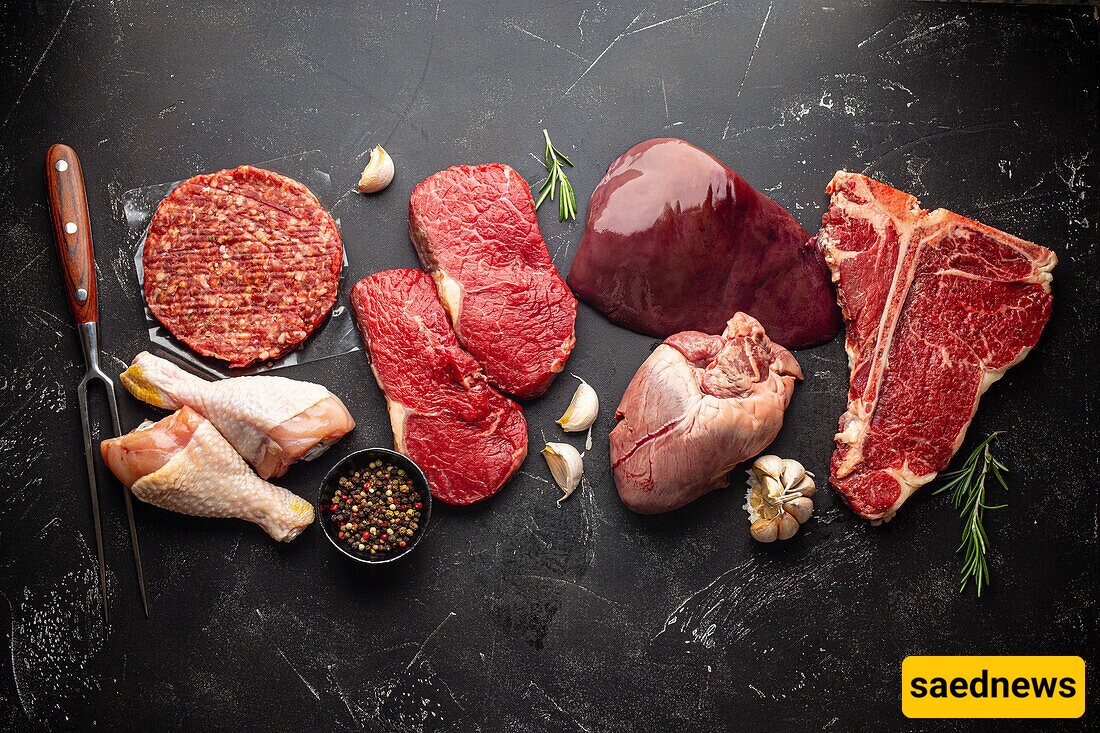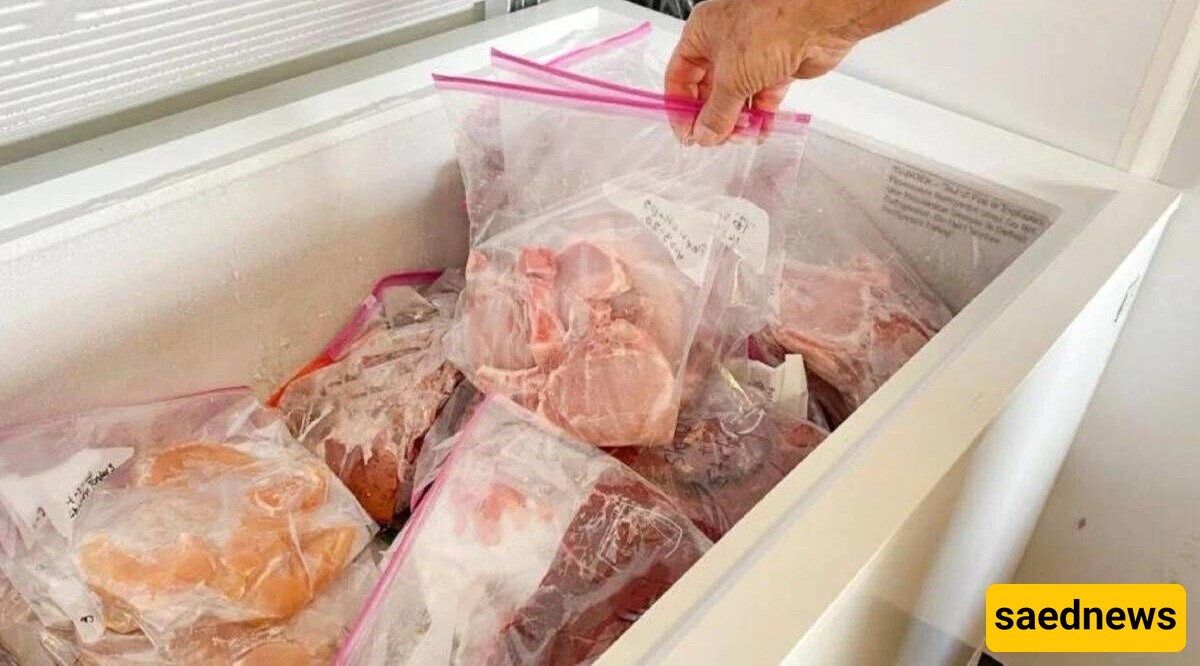Maintaining a healthy kitchen depends on your knowledge of cooking techniques and the safe storage of food, including various types of meat. In this article, we will explain the methods for storing red meat, fish, and poultry, as well as how to select and cook them properly.

According to the Family Magazine Service of Saed News, various types of bacteria can grow on animal products. Therefore, proper care and safe storage of different kinds of meat are essential. The guidelines for handling different types of meat can sometimes be confusing. Some meats can be consumed safely even a week after preparation or stored in the freezer for an extended period, while others must be discarded after just a few days. Understanding the safety principles for storing red meat, poultry, and fish is crucial.
Although safety considerations may depend on how you consume meat, in general, meat storage methods are quite similar under similar conditions. Maintaining a healthy kitchen also relies on your knowledge of cooking and food storage techniques.
Never buy meat past its expiration or sell-by date.
Purchase meat at the end of your shopping trip to minimize the time it remains outside refrigeration.
When selecting meat, consider the following:
Avoid lamb or beef that appears dark brown or colorless, has a strong odor, or feels sticky or slimy.
Do not buy poultry that looks old, has a strong smell, or feels slimy.
Avoid fish that looks pale, has changed color, feels slimy, or has a strong fishy or ammonia-like smell.
Do not purchase any meat that is in damaged, leaking, or torn packaging, as it may have been exposed to air and harmful bacteria.
Wash your hands frequently when handling red meat, fish, or poultry. Bacteria can transfer quickly from your hands to the meat. Always wash your hands with soap and water for at least 20 seconds before and after touching meat, whether raw or cooked.
Prevent cross-contamination by preparing meat on a separate surface from other cooking ingredients. Keep vegetables and other ingredients away from raw meat unless they will be cooked together. Ideally, use separate cutting boards for meat and other foods.
Clean all cooking utensils after they have come into contact with raw meat. Use separate serving dishes for cooked and raw meats.
Fresh, non-dried raw meat typically stays fresh in the refrigerator for up to three days. If you need to store uncooked meat for a longer period, freezing is the best option. Always place meat in a sealed package before freezing. Once frozen, meat can generally be stored for several months.
The storage time depends on the temperature:
Keep your freezer at or near 0°F (-17.8°C) to preserve nutrients and freshness.
Set your refrigerator at about 34°F (1.1°C) to extend food shelf life effectively.
Raw ground meat: 1–2 days
Poultry (chicken, turkey): 1–2 days
Seafood: 1–2 days
Raw roasts, steaks, and cuts of beef, veal, or lamb: 3–5 days
Cooked meat (including poultry and seafood): 3–4 days
Beef: 12 months
Ground beef: 6 months
Veal: 10 months
Lamb: 12 months
Whole chicken: 12 months
Chicken pieces: 9 months
Sausages and processed meats: 6 months
Fish: Should be stored at -30°C (-22°F) and can last up to 6 months.

To cook healthy meals, you must use proper thawing techniques. As soon as frozen meat warms above 4.5°C (40°F), bacteria that may have been present before freezing can start multiplying again.
The best defrosting temperature is 10–15°C (50–59°F). Below are various defrosting methods:
Frozen poultry (especially large birds) requires 24 hours per 2 kg (4.4 lbs) to thaw completely.
Ground meat or boneless chicken breast needs 24 hours to thaw.
Once thawed, ground meat, meat pieces, poultry, and seafood must be cooked within 24 hours, or bacteria may start growing.
You can safely use beef, lamb, or mutton pieces 3–5 days after defrosting in the fridge.
To thaw meat faster, place it in a leak-proof freezer bag and submerge it in cold water.
Change the water every 30 minutes until completely thawed.
500g (1.1 lbs) of meat thaws in about 1 hour, while 1.5–2 kg (3.3–4.4 lbs) takes 2–3 hours.
Meat thawed this way must be cooked immediately.
Use the “defrost” setting to ensure even thawing without partial cooking.
Meat thawed in the microwave should be cooked immediately and not refrozen without cooking first.
Cooking meat from frozen is not dangerous but may take longer. Always use a food thermometer to ensure the meat is cooked thoroughly.
However, meat cooked from frozen is not as fresh as properly thawed meat, so it’s better to thaw meat slowly before cooking for better flavor and longer shelf life.
Cooking temperature affects both flavor and food safety. The terms rare, medium, and well-done refer to the internal temperature of the meat, which should be measured with a meat thermometer.
Rare: 120–125°F (48.9–51.7°C)
Medium: 140–145°F (60–62.8°C)
Well-done: 165°F (73.9°C) or higher
Poultry: 165°F (73.9°C) for whole birds or pieces. Never eat raw poultry as it may cause salmonella or other infections.
Ground Meat: 160°F (71.1°C) for beef, lamb, and mutton. Bacteria can spread throughout ground meat, so it requires a higher temperature.
Meat Chunks (Steaks, Roasts, Chops): 145°F (62.8°C) with 3 minutes of resting timebefore eating.
Fish: 145°F (62.8°C) or until opaque and flakes easily with a fork.
The type and quality of fish determine safe cooking methods. Some fish should be fully cooked, while others, like sushi-grade fish, can be eaten raw with caution. Always buy sushi-safe fish to minimize contamination risk.
Fish: Should be opaque (not translucent) and flake easily.
Shellfish (e.g., clams, mussels): Shells must open after cooking. Discard any that remain closed.
Shrimp and crab: The meat should turn opaque and firm after cooking.
Never leave cooked seafood unrefrigerated for more than two hours.
Red meat, poultry, and fish are among the most popular foods worldwide but also have a high risk of food poisoning. To stay safe, follow proper storage, thawing, and cooking guidelines. This article has provided key tips for selecting, storing, and cooking meat to ensure your meals are both delicious and safe.

